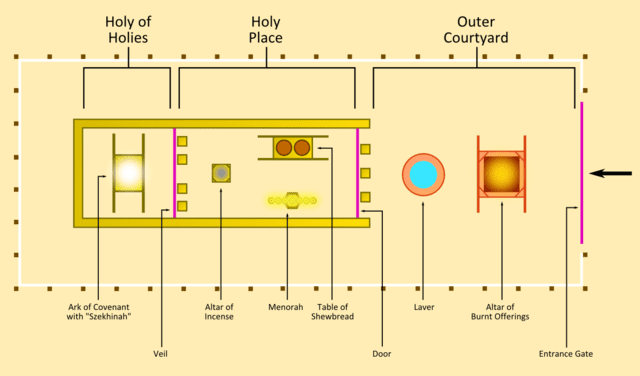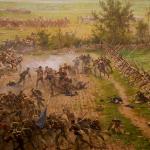Archaeology Entirely Backs Up the Extraordinary Accuracy of Holy Scripture Yet Again

The tabernacle, in the Old Testament, was the forerunner of the temple. It was a portable tent (used in the wilderness wanderings and before the temple was completed under Solomon, that contained an outer court for sacrifices, and the inner holy of holies, which contained the famous ark of the covenant. The old 1911 Catholic Encyclopedia article on it provides a helpful description:
In this sanctuary we should distinguish the tent or tabernacle proper from the sacred enclosure in which the tent stood. The “court of the tabernacle” (Exodus 27:9) was a rectangular space, measuring 100 by 50 cubits (probably the Egyptian cubit, 203/4 ins.), screened off by curtains of “fine twisted linen” (xxvii, 9), 5 cubits high, 100 cubits long on the north and south sides, 50 on the east and 15 on the west, and 20 cubits on either side of the entrance. The entrance was closed by a hanging of fine twisted linen, embroidered in violet, purple, and scarlet and “twice dyed” on a white ground (probable meaning of Exodus 27:16).
All these curtains were suspended from sixty pillars, but not in a “loose and flowing manner”, as Josephus wrongly states, since the total length of the curtains is exactly the same as the perimeter of the court, one pillar being assigned to every five cubits of curtain. These pillars of setimwood, five cubits high, stood on bases (“sockets”, Exodus 39:39) of brass and were held in position by means of cords (ibid., xxxix, 40) fastened to brass pegs (“pins”, ibid., xxxv, 18) which were stuck in the ground; the pillars ended in a capital (“head”, Exodus 39:17, etc.; we must believe that the height given above includes both the base and capital of the pillar) with a band or necking (to hang the curtain) overlaid with silver.
East of the entrance were found successively: the altar of holocausts (Exodus 27:1-8, etc.), the brazen layer (xxx, 18-21; xxxviii, 8, etc.), and the tabernacle proper. The latter was conceived to be the dwelling-tent of God; hence it consisted essentially of curtains, the wooden framework, though indispensable, being only of secondary importance. The whole structure measured 30 by 10 cubits, and was divided into two sections; the one to the west, the “Holy Place”, containing the altar of incense, the golden candlestick, and the table of shewbreads; and the other, the “Holy of Holies”, containing the Ark of the Covenant with the propitiatory and the cherubim. These sections were respectively 20 and 10 cubits long.
Jewish exegetical tradition, followed by almost every Christian exponent of the Bible, understood the wooden framework to be made up of 48 massive boards (rather beams) of setim wood, measuring 10 by 11/2 by 1 cubit, placed side by side. This means a weight (about fifty tons) out of proportion with what these beams would have to bear and very difficult of transportation. Some modern scholars having studied more closely the technical terms used in the original adopt another view. According to them the “boards” of the tabernacle must be understood as light frames consisting of two uprights joined (probably at the top, middle, and bottom) by ties or cross-rails (the “mortises” in Exodus 26:17).
Of these frames, overlaid with gold (xxvi, 29), there were 20 on the north side of the tabernacle, 20 on the south, and 6 on the east. To provide solidity and rigidity, a slanting frame was put at the north-east and south-east corners to buttress the structure (xxvi, 23); the lower part of the uprights was sunk deep into silver sockets or bases, probably to be understood as square blocks (about 1 cubit high and 3/4 cubit square); finally, five wooden bars, passing through rings attached to the frames, ran along the sides (xxvi, 26-28). On the west the frames were to be replaced by five pillars of setimwood overlaid with gold, sunk in brass bases, and crowned with golden capitals (xxvi, 37). Four pillars of the same workmanship, with silver bases, separated the Holy Place from the Holy of Holies.
A curtain, two pieces of fine tapestry joined by golden rings, was spread over the whole framework; each piece of tapestry consisted of five strips, 28 by 4 cubits, fitted together by loops. The total dimension of this being 20 by 40 cubits, it must have reached on the north and south the top of the bases, against which it was possibly fixed (there were loops at the top of the curtains likely for this purpose), whereas on the east it reached to the ground. Covering this curtain was another woven of goats’ hair (the ordinary tent material), fitted in somewhat similarly; its dimensions, 11 (6+5)x4=44 by 30 cubits, were so calculated as to cover entirely the inside curtain on the north, east, and south sides and to hang down doubled on the west side, thus covering the tops and capitals of the pillars (Exodus 26:7-13). Two outer coverings (no dimensions are given), one of dyed rams’ skin and one of dugongs’ skin, protected the whole structure. A hanging of apparently the same workmanship as that closing the entrance of the court, screened the entrance of the tabernacle (ibid., 36); finally, a veil of the same tapestry as the inner curtain, hooked from the four pillars mentioned above, completed the separation of the Holy of Holies from the Holy Place.
Egyptologist, archaeologist, and evangelical Protestant, Kenneth A. Kitchen, probably the greatest living biblical “maximalist” archaeologist, in his book, On the Reliability of the Old Testament, Grand Rapids and Cambridge: William B. Eerdmans Publishing Company, 2003), made a case for the 13th century origin and building of the tabernacle (i.e., in Moses’ time, and during the wanderings in the desert after the Exodus), over against the “minimalist” archaeologists. Here is how he constructs it:
There can be no excuse nowadays for artificially down-dating the Hebrew usages by six or seven centuries, for purely nineteenth-century doctrinaire reasons. . . .
Well over a century ago Wellhausen and others . . . [thought that a divine] command [to build the tabernacle] was originally followed only by a summary note of its fulfillment, and all else that we read now is material added at later time(s).
However, much more recent investigation has shown this “modern” concept to be wrong, and the existing format of Exod. 25-40, etc., to be original, i.e., true to ancient usage in the third and second millennia [BC] in particular. . . .
Thus the old nineteenth-century dogmas must be abandoned in the face of those facts. . . .
Thus, for the Sinai tabernacle, in retrospect, we possess a considerable — and growing — amount of valuable comparative data (much of it very old, and much, contemporary; far less, of later date) that favor the hypothesis that a small but well-decorated dismountable tent shrine (based on usages of its time) accompanied the Hebrews from Sinai to Canaan, . . . (pp. 282-283)
Wikipedia (“Tabernacle”) notes the present fashionable skepticism as to the date of its origins:
Many scholars contend that it is of a far later date than the time of Moses, and that the description reflects the structure of Solomon’s Temple, while some hold that the description derives from memories of a real pre-monarchic shrine, perhaps the sanctuary at Shiloh. Traditional scholars contend that it describes an actual tabernacle used in the time of Moses and thereafter.
Kitchen contends that every aspect of the Hebrew tabernacle has similarities to prior such structures in surrounding cultures: especially Egypt. All of these parallels suggest (by analogy and correspondence to the biblical text) a 13th century origin, and not a later one. He explains the scholarly options, earlier in his treatment of this topic:
In biblical studies, for over a century, “critical orthodoxy” (current “minimalism” being no different) has decreed that the tabernacle is an exilic or postexilic figment of the imagination of Jewish priests (ca. sixth to fourth centuries B.C.), seeking to glorify their cult, giving it a long “history” before the monarchy by projecting a “tented” form of Solomon’s temple back to the time of Moses, their first national leader. . . .
[I]f inquiry demonstrates clear analogues from earlier epochs, an in particular before the Hebrew monarchy, and with very little such data after circa 1000, then it would be in order to suggest that there could well have been a tent shrine in early Israel that was eventually replaced by the temple of Solomon’s time. Late-period priests might conceivably have preserved record of an early structure; but mere imagination would not then have originated it. (pp. 275-276)
He then systematically describes all sorts of parallels to the Hebrew tabernacle, in or before the period where it was traditionally believed to have been first made (13th c. BC):
[I]n the 1920s, . . . a brilliant discovery by Reisner at the Giza pyramids in Egypt opened up the final tomb of Queen Hetepheres, mother of Khufu, the builder of the Great Pyramid, circa 2600. He found the disassembled parts of a “secular tabernacle” . . . It consisted of a wooden framework, gold covered, that fitted together with tenon and socket joints. The top horizontal beams were supported by vertical poles set in base beams. The corners were held by special fitments, a feature also of the biblical tabernacle (Exod. 26:23). The whole framework was once draped with curtains that had not survived. . . .
Thus, in Egypt, most of the biblical tabernacle’s technology was literally “as old as the Pyramids,” in fact older. But all this is still a thousand years before even a Moses, never mind exilic priests. (p. 276).
However, our story is not done. Recent publications of texts from the famous kingdom of Mari on the Middle Euphrates of circa eighteenth (or seventeenth) century now yield mention of tents or “tabernacles” borne on wooden frames . . . and units of (seemingly) fencing, latticework, perhaps to form an enclosure as with the biblical tabernacle (Exod. 27:9-10). . . .
Thus large tents over wooden frames set in socketed bases were used for both ritual and royal purposes at Mari, still half a millennium before any Moses. (p. 277)
He provides further similar examples from the tomb of Tutankhamun (ca. 1336 1327 BC): “concentric tabernacle-like shrines . . . gold-plated, dismountable, and fitted together with tenons in sockets like the Hebrew tabernacle . . . a wooden framework carrying a pall of faded linen decorated with gilded bronze rosettes, for all the world like a skeletal tabernacle” (p. 278).
Pharaoh Ramesses, around 1275 BC — very near the time of the Exodus, had a “rectangular tent . . . divided into two parts, with an outer room twice the length of the inner room of the king himself. In some representations the inner room has figures of divine falcons facing each other and shadowing the royal name with their wings, much as the cherubim did for the cover of the ark in the tabernacle” (p. 278)
Kitchen noted that “multicolored curtains . . . would be in no way too elaborate” in the 13th c. BC. “Such techniques were ages old by then, even commonplace” (p. 278). A ship of Pharaoh Sahure (c. 2465 -c. 2325 BC) had “squared-off rosettes and stars” and a “New Kingdom [1570 BC and after] tomb has a boat with a checker-patterned red-and-white sail” (p. 278)
He goes on to cite further striking precursors of sacred and ritualistic Hebrew items:
On furnishings we may cite the ark of the covenant (Exod. 25:10-22; 37:1-9) and the special silver trumpets of Num. 10:1-10. The former was essentially a gilded box on four feet, with four rings (two each side) to take two carrying-poles. The arrangement is identical to that of a famous box from Tutankhamun’s tomb, with just such rings and poles. . . . Thus the ark is a typical Late Bronze Age item.
[T]he silver trumpets . . . were long tubes with flared mouths. These too were in type and use characteristic of New Kingdom Egypt. From Tutankhamun’s tomb (again!) we have two such trumpets, one of silver, one of copper and bronze overlaid with gold. Such instruments are commonly shown in scenes, used exactly in the functions described in Num. 10. . . . Of the Late Bronze Age (not later), as others have pointed out, are the tabernacle’s lampstand and various other facets. (p. 280)
***
Photo credit: Adik86 (9-18-09) [Wikimedia Commons / Creative Commons Attribution-Share Alike 3.0 Unported license]
***
Summary: Egyptologist & archaeologist Kenneth Kitchen shows the parallels between the wilderness Hebrew Tabernacle from Moses’ time (13th c. BC), & Egyptian & other precursors.













